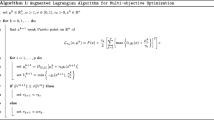Abstract
Relationships between the Tchebycheff scalarization and the augmented Lagrange multiplier technique are examined in the framework of general multiple objective programs (MOPs). It is shown that under certain conditions the Tchebycheff method can be represented as a quadratic weighted-sums scalarization of the MOP, that is, given weight values in the former, the coefficients of the latter can be found so that the same efficient point is selected. Analysis for concave and linear MOPs is included. Resulting applications in multiple criteria decision making are also discussed.
Similar content being viewed by others
References
Ballestro, E. and Romero, C. (1991), A theorem connecting utility function optimization and compromise programming, Operations Research Letters 10: 421-427.
Bazaraa, M.S., Jarvis, J.J. and Sherali, H.D. (1990), Linear Programming and Network Flows, Wiley, New York.
Bazaraa, M.S., Sherali, H.D. and Shetty C.M. (1993), Nonlinear Programming-Theory and Algorithms, Wiley, New York.
Bowman, V.J. (1976), On the relationship of the Tchebycheff norm and the efficient frontier of multiple-criteria objectives, Lecture Notes in Economics and Mathematical Systems 130: 76-85.
Choo, E.-U. and Atkins, D.R. (1980), An interactive algorithm for multicriteria programming, Computers and Operations Research 7: 81-87.
Ecker, J.G. and Shoemaker, N.E. (1981), Selecting subsets from the set of nondominated vectors in multiple objective linear programming, SIAM Journal on Control and Optimization 19: 505-515.
Everett, H. (1963), Generalized Lagrange multiplier method for solving problems of optimum allocation of resources, Operations Research 11: 399-417.
Geoffrion, A.M. (1968), Proper efficiency and the theory of vector maximization, Journal of Mathematical Analysis and Applications 22: 618-630.
Gould, F.J. (1969), Extensions of Lagrange multipliers in nonlinear programming, SIAM Journal of Applied Mathematics 17: 1280-1297.
Kaliszewski, I. (1987), A modified weighted Tchebycheff metric for multiple objective programming, Computers and Operations Research 14: 315-323.
Minoux, M. (1986), Mathematical Programming: Theory and Algorithms, Wiley, Chichester.
Moron, M.A., Romero, C., and Ruiz del Portal, F. (1996), Generating well-behaved utility functions for compromise programming, Journal of Optimization Theory and Applications 91: 643-649.
Nakayama, H., Sayama, H. and Sawaragi, Y. (1975), A generalized Lagrangian function and multiplier method, Journal of Optimization Theory and Applications 17: 211-227.
Rockafellar, R.T. (1974), Augmented Lagrange multiplier functions and duality in nonconvex programming, SIAM Journal on Control 12: 268-285.
Roode, J.D. (1968), Generalized Lagrangian Functions in Mathematical Programming, Ph.D. Thesis, University of Leiden, The Netherlands.
Singh, C., Bhatia, D. and Rueda, N. (1996), Duality in nonlinear multiobjective programming using augmented Lagrangian functions, Journal of Optimization Theory and Applications 88: 659-670.
Steuer R.E. (1986), Multiple Criteria Optimization: Theory, Computation and Application, Wiley, New York.
Steuer, R.E. and Choo, E.-U. (1983), An interactive weighted Tchebycheff procedure for multiple objective programming, Mathematical Programming 26: 326-344.
TenHuisen, M.L. and Wiecek, M.M. (1994), Vector optimization and generalized Lagrangian duality, Annals of Operations Research 51: 15-32.
TenHuisen, M.L. and Wiecek, M.M. (1997), Efficiency and solution approaches to bicriteria nonconvex programs, Journal of Global Optimization 11: 225-251.
TenHuisen, M.L. and Wiecek, M.M., (1997) An augmented Lagrangian scalarization for multiple objective programming, in: R. Caballero, F. Ruiz, R.E. Steuer (eds.), Advances in Multiple Objective and Goal Programming, pp. 151-159, Springer, Berlin.
Tind, J. and Wolsey, L.A. (1981), An elementary survey of general duality theory in mathematical programming, Mathematical Programming 21: 241-261.
Wierzbicki, A.P. (1980), The use of reference objectives in multiobjective optimization, Lecture Notes in Economics and Mathematical Systems 177: 468-486.
Yu, P.L. (1973), A class of solutions for group decision problems, Management Science 19: 262-301.
Zeleny, M.(1973), Compromise programming, in: J.L. Cochrane and M. Zeleny, (eds.), Multiple Criteria Decision Making, pp. 262-301, University of South Carolina Press, Columbia, S.C.
Author information
Authors and Affiliations
Rights and permissions
About this article
Cite this article
Tind, J., Wiecek, M.M. Augmented Lagrangian and Tchebycheff Approaches in Multiple Objective Programming. Journal of Global Optimization 14, 251–266 (1999). https://doi.org/10.1023/A:1008314306344
Issue Date:
DOI: https://doi.org/10.1023/A:1008314306344




